Naofal Al-Dhahir
FAS-RIS for V2X: Unlocking Realistic Performance Analysis with Finite Elements
Dec 22, 2025Abstract:The synergy of fluid antenna systems (FAS) and reconfigurable intelligent surfaces (RIS) is poised to unlock robust Vehicle-to-Everything (V2X) communications. However, a critical gap persists between theoretical predictions and real-world performance. Existing analyses predominantly rely on the Central Limit Theorem (CLT), an assumption valid only for a large number of RIS elements, which fails to represent practical, finite-sized deployments constrained by cost and urban infrastructure. This paper bridges this gap by presenting a novel framework that unlocks a realistic performance analysis for FAS-RIS systems with finite elements. Leveraging a Gamma distribution approximation, we derive a new, tractable closed-form expression for the outage probability. Numerical results validate our approach, demonstrating that it offers a significantly more accurate performance characterization than conventional CLT-based methods, particularly in the practical regime of small-scale RIS. This work provides a crucial foundation for the design and deployment of reliable FAS-RIS-aided vehicular networks.
Coordinated Beamforming for Networked Integrated Communication and Multi-TMT Localization
Oct 06, 2025Abstract:Networked integrated sensing and communication (ISAC) has gained significant attention as a promising technology for enabling next-generation wireless systems. To further enhance networked ISAC, delegating the reception of sensing signals to dedicated target monitoring terminals (TMTs) instead of base stations (BSs) offers significant advantages in terms of sensing capability and deployment flexibility. Despite its potential, the coordinated beamforming design for networked integrated communication and time-of-arrival (ToA)-based multi-TMT localization remains largely unexplored. In this paper, we present a comprehensive study to fill this gap. Specifically, we first establish signal models for both communication and localization, and, for the first time, derive a closed-form Cram\'er-Rao lower bound (CRLB) to characterize the localization performance. Subsequently, we exploit this CRLB to formulate two optimization problems, focusing on sensing-centric and communication-centric criteria, respectively. For the sensing-centric problem, we develop a globally optimal algorithm based on semidefinite relaxation (SDR) when each BS is equipped with more antennas than the total number of communication users. While for the communication-centric problem, we design a globally optimal algorithm for the single-BS case using bisection search. For the general case of both problems, we propose a unified successive convex approximation (SCA)-based algorithm, which is suboptimal yet efficient, and further extend it from single-target scenarios to more practical multi-target scenarios. Finally, simulation results demonstrate the effectiveness of our proposed algorithms, reveal the intrinsic performance trade-offs between communication and localization, and further show that deploying more TMTs is always preferable to deploying more BSs in networked ISAC systems.
Energy-Efficient Hybrid Beamfocusing for Near-Field Integrated Sensing and Communication
Aug 06, 2025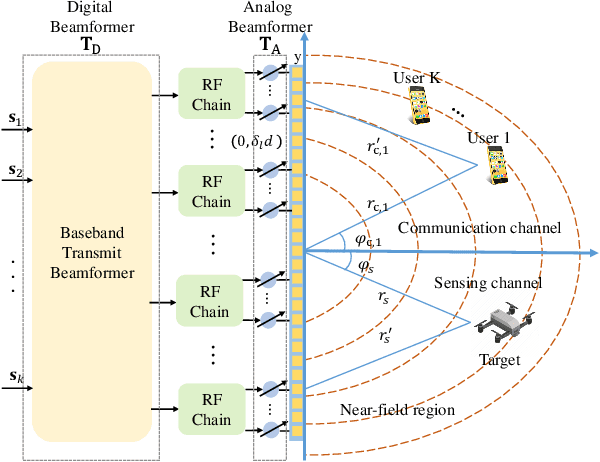
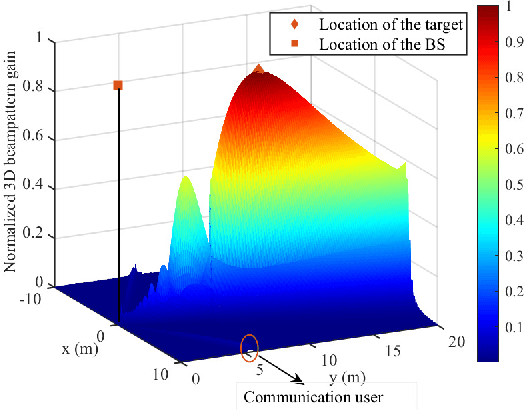
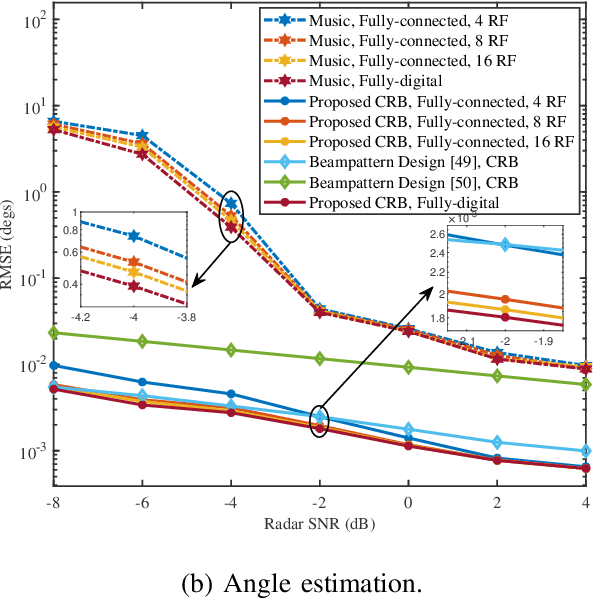
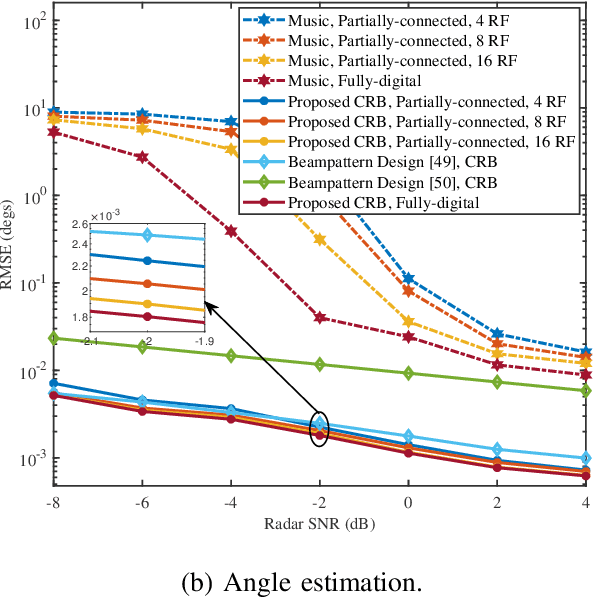
Abstract:Integrated sensing and communication (ISAC) is a pivotal component of sixth-generation (6G) wireless networks, leveraging high-frequency bands and massive multiple-input multiple-output (M-MIMO) to deliver both high-capacity communication and high-precision sensing. However, these technological advancements lead to significant near-field effects, while the implementation of M-MIMO \mbox{is associated with considerable} hardware costs and escalated power consumption. In this context, hybrid architecture designs emerge as both hardware-efficient and energy-efficient solutions. Motivated by these considerations, we investigate the design of energy-efficient hybrid beamfocusing for near-field ISAC under two distinct target scenarios, i.e., a point target and an extended target. Specifically, we first derive the closed-form Cram\'{e}r-Rao bound (CRB) of joint angle-and-distance estimation for the point target and the Bayesian CRB (BCRB) of the target response matrix for the extended target. Building on these derived results, we minimize the CRB/BCRB by optimizing the transmit beamfocusing, while ensuring the energy efficiency (EE) of the system and the quality-of-service (QoS) for communication users. To address the resulting \mbox{nonconvex problems}, we first utilize a penalty-based successive convex approximation technique with a fully-digital beamformer to obtain a suboptimal solution. Then, we propose an efficient alternating \mbox{optimization} algorithm to design the analog-and-digital beamformer. \mbox{Simulation} results indicate that joint distance-and-angle estimation is feasible in the near-field region. However, the adopted hybrid architectures inevitably degrade the accuracy of distance estimation, compared with their fully-digital counterparts. Furthermore, enhancements in system EE would compromise the accuracy of target estimation, unveiling a nontrivial tradeoff.
Polarized 6D Movable Antenna for Wireless Communication: Channel Modeling and Optimization
Jun 04, 2025Abstract:In this paper, we propose a novel polarized six-dimensional movable antenna (P-6DMA) to enhance the performance of wireless communication cost-effectively. Specifically, the P-6DMA enables polarforming by adaptively tuning the antenna's polarization electrically as well as controls the antenna's rotation mechanically, thereby exploiting both polarization and spatial diversity to reconfigure wireless channels for improving communication performance. First, we model the P-6DMA channel in terms of transceiver antenna polarforming vectors and antenna rotations. We then propose a new two-timescale transmission protocol to maximize the weighted sum-rate for a P-6DMA-enhanced multiuser system. Specifically, antenna rotations at the base station (BS) are first optimized based on the statistical channel state information (CSI) of all users, which varies at a much slower rate compared to their instantaneous CSI. Then, transceiver polarforming vectors are designed to cater to the instantaneous CSI under the optimized BS antennas' rotations. Under the polarforming phase shift and amplitude constraints, a new polarforming and rotation joint design problem is efficiently addressed by a low-complexity algorithm based on penalty dual decomposition, where the polarforming coefficients are updated in parallel to reduce computational time. Simulation results demonstrate the significant performance advantages of polarforming, antenna rotation, and their joint design in comparison with various benchmarks without polarforming or antenna rotation adaptation.
Modeling and Performance Analysis for Semantic Communications Based on Empirical Results
Apr 29, 2025
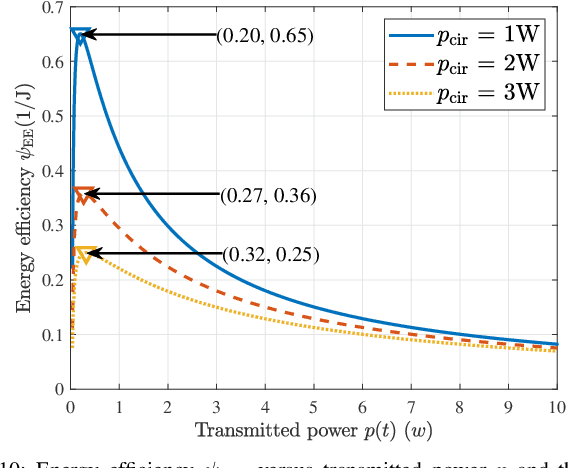

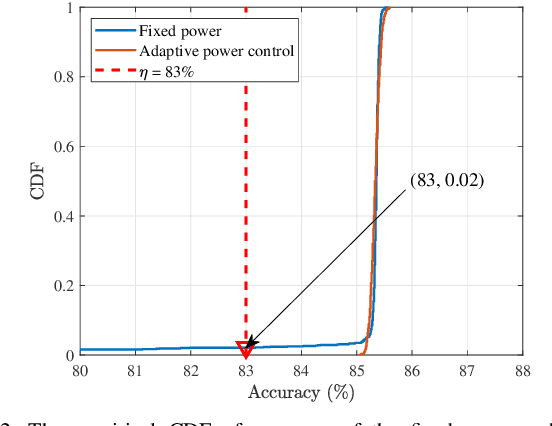
Abstract:Due to the black-box characteristics of deep learning based semantic encoders and decoders, finding a tractable method for the performance analysis of semantic communications is a challenging problem. In this paper, we propose an Alpha-Beta-Gamma (ABG) formula to model the relationship between the end-to-end measurement and SNR, which can be applied for both image reconstruction tasks and inference tasks. Specifically, for image reconstruction tasks, the proposed ABG formula can well fit the commonly used DL networks, such as SCUNet, and Vision Transformer, for semantic encoding with the multi scale-structural similarity index measure (MS-SSIM) measurement. Furthermore, we find that the upper bound of the MS-SSIM depends on the number of quantized output bits of semantic encoders, and we also propose a closed-form expression to fit the relationship between the MS-SSIM and quantized output bits. To the best of our knowledge, this is the first theoretical expression between end-to-end performance metrics and SNR for semantic communications. Based on the proposed ABG formula, we investigate an adaptive power control scheme for semantic communications over random fading channels, which can effectively guarantee quality of service (QoS) for semantic communications, and then design the optimal power allocation scheme to maximize the energy efficiency of the semantic communication system. Furthermore, by exploiting the bisection algorithm, we develop the power allocation scheme to maximize the minimum QoS of multiple users for OFDMA downlink semantic communication Extensive simulations verify the effectiveness and superiority of the proposed ABG formula and power allocation schemes.
Pinching-Antenna Systems (PASS)-enabled Secure Wireless Communications
Apr 18, 2025Abstract:A novel pinching-antenna systems (PASS)-enabled secure wireless communication framework is proposed. By dynamically adjusting the positions of dielectric particles, namely pinching antennas (PAs), along the waveguides, PASS introduces a novel concept of pinching beamforming to enhance the performance of physical layer security. A fundamental PASS-enabled secure communication system is considered with one legitimate user and one eavesdropper. Both single-waveguide and multiple-waveguide scenarios are studied. 1) For the single-waveguide scenario, the secrecy rate (SR) maximization is formulated to optimize the pinching beamforming. A PA-wise successive tuning (PAST) algorithm is proposed, which ensures constructive signal superposition at the legitimate user while inducing a destructive legitimate signal at the eavesdropper. 2) For the multiple-waveguide scenario, artificial noise (AN) is employed to further improve secrecy performance. A pair of practical transmission architectures are developed: waveguide division (WD) and waveguide multiplexing (WM). The key difference lies in whether each waveguide carries a single type of signal or a mixture of signals with baseband beamforming. For the SR maximization problem under the WD case, a two-stage algorithm is developed, where the pinching beamforming is designed with the PAST algorithm and the baseband power allocation among AN and legitimate signals is solved using successive convex approximation (SCA). For the WM case, an alternating optimization algorithm is developed, where the baseband beamforming is optimized with SCA and the pinching beamforming is designed employing particle swarm optimization.
UAV Cognitive Semantic Communications Enabled by Knowledge Graph for Robust Object Detection
Feb 06, 2025



Abstract:Unmanned aerial vehicles (UAVs) are widely used for object detection. However, the existing UAV-based object detection systems are subject to severe challenges, namely, their limited computation, energy and communication resources, which limits the achievable detection performance. To overcome these challenges, a UAV cognitive semantic communication system is proposed by exploiting a knowledge graph. Moreover, we design a multi-scale codec for semantic compression to reduce data transmission volume while guaranteeing detection performance. Considering the complexity and dynamicity of UAV communication scenarios, a signal-to-noise ratio (SNR) adaptive module with robust channel adaptation capability is introduced. Furthermore, an object detection scheme is proposed by exploiting the knowledge graph to overcome channel noise interference and compression distortion. Simulation results conducted on the practical aerial image dataset demonstrate that our proposed semantic communication system outperforms benchmark systems in terms of detection accuracy, communication robustness, and computation efficiency, especially in dealing with low bandwidth compression ratios and low SNR regimes.
A Hybrid Dynamic Subarray Architecture for Efficient DOA Estimation in THz Ultra-Massive Hybrid MIMO Systems
Jan 30, 2025Abstract:Terahertz (THz) communication combined with ultra-massive multiple-input multiple-output (UM-MIMO) technology is promising for 6G wireless systems, where fast and precise direction-of-arrival (DOA) estimation is crucial for effective beamforming. However, finding DOAs in THz UM-MIMO systems faces significant challenges: while reducing hardware complexity, the hybrid analog-digital (HAD) architecture introduces inherent difficulties in spatial information acquisition the large-scale antenna array causes significant deviations in eigenvalue decomposition results; and conventional two-dimensional DOA estimation methods incur prohibitively high computational overhead, hindering fast and accurate realization. To address these challenges, we propose a hybrid dynamic subarray (HDS) architecture that strategically divides antenna elements into subarrays, ensuring phase differences between subarrays correlate exclusively with single-dimensional DOAs. Leveraging this architectural innovation, we develop two efficient algorithms for DOA estimation: a reduced-dimension MUSIC (RD-MUSIC) algorithm that enables fast processing by correcting large-scale array estimation bias, and an improved version that further accelerates estimation by exploiting THz channel sparsity to obtain initial closed-form solutions through specialized two-RF-chain configuration. Furthermore, we develop a theoretical framework through Cram\'{e}r-Rao lower bound analysis, providing fundamental insights for different HDS configurations. Extensive simulations demonstrate that our solution achieves both superior estimation accuracy and computational efficiency, making it particularly suitable for practical THz UM-MIMO systems.
From Partial Calibration to Full Potential: A Two-Stage Sparse DOA Estimation for Incoherently-Distributed Sources with Gain-Phase Uncertainty
Jan 28, 2025

Abstract:Direction-of-arrival (DOA) estimation for incoherently distributed (ID) sources is essential in multipath wireless communication scenarios, yet it remains challenging due to the combined effects of angular spread and gain-phase uncertainties in antenna arrays. This paper presents a two-stage sparse DOA estimation framework, transitioning from partial calibration to full potential, under the generalized array manifold (GAM) framework. In the first stage, coarse DOA estimates are obtained by exploiting the output from a subset of partly-calibrated arrays (PCAs). In the second stage, these estimates are utilized to determine and compensate for gain-phase uncertainties across all array elements. Then a sparse total least-squares optimization problem is formulated and solved via alternating descent to refine the DOA estimates. Simulation results demonstrate that the proposed method attained improved estimation accuracy compared to existing approaches, while maintaining robustness against both noise and angular spread effects in practical multipath environments.
Interference-Robust Broadband Rapidly-Varying MIMO Communications: A Knowledge-Data Dual Driven Framework
Dec 26, 2024Abstract:A novel time-efficient framework is proposed for improving the robustness of a broadband multiple-input multiple-output (MIMO) system against unknown interference under rapidly-varying channels. A mean-squared error (MSE) minimization problem is formulated by optimizing the beamformers employed. Since the unknown interference statistics are the premise for solving the formulated problem, an interference statistics tracking (IST) module is first designed. The IST module exploits both the time- and spatial-domain correlations of the interference-plus-noise (IPN) covariance for the future predictions with data training. Compared to the conventional signal-free space sampling approach, the IST module can realize zero-pilot and low-latency estimation. Subsequently, an interference-resistant hybrid beamforming (IR-HBF) module is presented, which incorporates both the prior knowledge of the theoretical optimization method as well as the data-fed training. Taking advantage of the interpretable network structure, the IR-HBF module enables the simplified mapping from the interference statistics to the beamforming weights. The simulations are executed in high-mobility scenarios, where the numerical results unveil that: 1) the proposed IST module attains promising prediction accuracy compared to the conventional counterparts under different snapshot sampling errors; and 2) the proposed IR-HBF module achieves lower MSE with significantly reduced computational complexity.
 Add to Chrome
Add to Chrome Add to Firefox
Add to Firefox Add to Edge
Add to Edge